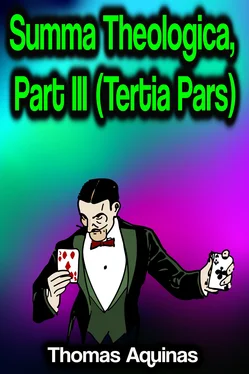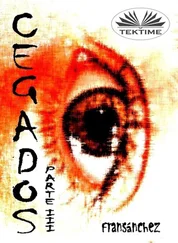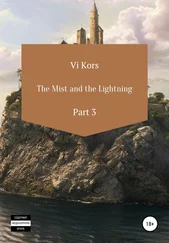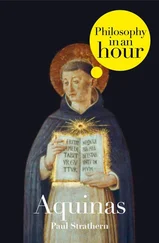Obj. 5: Further, all those who are mentioned in Christ's genealogy had both a father and a mother, and many of them had brothers also. Now in Christ's genealogy Matthew mentions only three mothers—namely, Thamar, Ruth, and the wife of Urias. He also mentions the brothers of Judas and Jechonias, and also Phares and Zara. But Luke mentions none of these. Therefore the evangelists seem to have described the genealogy of Christ in an unsuitable manner.
On the contrary, The authority of Scripture suffices.
I answer that, As is written (2 Tim. 3:16), "All Holy Scripture is inspired of God [Vulg.: 'All scripture inspired of God is profitable'], etc. Now what is done by God is done in perfect order, according to Rom. 13:1: "Those that are of God are ordained [Vulg.: 'Those that are, are ordained of God']." Therefore Christ's genealogy is set down by the evangelists in a suitable order.
Reply Obj. 1: As Jerome says on Matt. 1, Isaias speaks of the generation of Christ's Godhead. Whereas Matthew relates the generation of Christ in His humanity; not indeed by explaining the manner of the Incarnation, which is also unspeakable; but by enumerating Christ's forefathers from whom He was descended according to the flesh.
Reply Obj. 2: Various answers have been made by certain writers to this objection which was raised by Julian the Apostate; for some, as Gregory of Nazianzum, say that the people mentioned by the two evangelists are the same, but under different names, as though they each had two. But this will not stand: because Matthew mentions one of David's sons—namely, Solomon; whereas Luke mentions another—namely, Nathan, who according to the history of the kings (2 Kings 5:14) were clearly brothers.
Wherefore others said that Matthew gave the true genealogy of Christ: while Luke gave the supposititious genealogy; hence he began: "Being (as it was supposed) the son of Joseph." For among the Jews there were some who believed that, on account of the crimes of the kings of Juda, Christ would be born of the family of David, not through the kings, but through some other line of private individuals.
Others again have supposed that Matthew gave the forefathers according to the flesh: whereas Luke gave these according to the spirit, that is, righteous men, who are called (Christ's) forefathers by likeness of virtue.
But an answer is given in the Qq. Vet. et Nov. Test. [*Part i, qu. lvi; part 2, qu. vi] to the effect that we are not to understand that Joseph is said by Luke to be the son of Heli: but that at the time of Christ, Heli and Joseph were differently descended from David. Hence Christ is said to have been supposed to be the son of Joseph, and also to have been the son of Heli as though (the Evangelist) were to say that Christ, from the fact that He was the son of Joseph, could be called the son of Heli and of all those who were descended from David; as the Apostle says (Rom. 9:5): "Of whom" (viz. the Jews) "is Christ according to the flesh."
Augustine again gives three solutions (De Qq. Evang. ii), saying: "There are three motives by one or other of which the evangelist was guided. For either one evangelist mentions Joseph's father of whom he was begotten; whilst the other gives either his maternal grandfather or some other of his later forefathers; or one was Joseph's natural father: the other is father by adoption. Or, according to the Jewish custom, one of those having died without children, a near relation of his married his wife, the son born of the latter union being reckoned as the son of the former": which is a kind of legal adoption, as Augustine himself says (De Consensu Evang. ii, Cf. Retract. ii).
This last motive is the truest: Jerome also gives it commenting on Matt. 1:16; and Eusebius of Caesarea in his Church history (I, vii), says that it is given by Africanus the historian. For these writers say that Mathan and Melchi, at different times, each begot a son of one and the same wife, named Estha. For Mathan, who traced his descent through Solomon, had married her first, and died, leaving one son, whose name was Jacob: and after his death, as the law did not forbid his widow to remarry, Melchi, who traced his descent through Mathan, being of the same tribe though not of the same family as Mathan, married his widow, who bore him a son, called Heli; so that Jacob and Heli were uterine brothers born to different fathers. Now one of these, Jacob, on his brother Heli dying without issue, married the latter's widow, according to the prescription of the law, of whom he had a son, Joseph, who by nature was his own son, but by law was accounted the son of Heli. Wherefore Matthew says "Jacob begot Joseph": whereas Luke, who was giving the legal genealogy, speaks of no one as begetting.
And although Damascene (De Fide Orth. iv) says that the Blessed Virgin Mary was connected with Joseph in as far as Heli was accounted as his father, for he says that she was descended from Melchi: yet must we also believe that she was in some way descended from Solomon through those patriarchs enumerated by Matthew, who is said to have set down Christ's genealogy according to the flesh; and all the more since Ambrose states that Christ was of the seed of Jechonias.
Reply Obj. 3: According to Augustine (De Consensu Evang. ii) "Matthew purposed to delineate the royal personality of Christ; Luke the priestly personality: so that in Matthew's genealogy is signified the assumption of our sins by our Lord Jesus Christ": inasmuch as by his carnal origin "He assumed 'the likeness of sinful flesh.' But in Luke's genealogy the washing away of our sins is signified," which is effected by Christ's sacrifice. "For which reason Matthew traces the generations downwards, Luke upwards." For the same reason too "Matthew descends from David through Solomon, in whose mother David sinned; whereas Luke ascends to David through Nathan, through whose namesake, the prophet, God expiated his sin." And hence it is also that, because "Matthew wished to signify that Christ had condescended to our mortal nature, he set down the genealogy of Christ at the very outset of his Gospel, beginning with Abraham and descending to Joseph and the birth of Christ Himself. Luke, on the contrary, sets forth Christ's genealogy not at the outset, but after Christ's Baptism, and not in the descending but in the ascending order: as though giving prominence to the office of the priest in expiating our sins, to which John bore witness, saying: 'Behold Him who taketh away the sin of the world.' And in the ascending order, he passes Abraham and continues up to God, to whom we are reconciled by cleansing and expiating. With reason too he follows the origin of adoption; because by adoption we become children of God: whereas by carnal generation the Son of God became the Son of Man. Moreover he shows sufficiently that he does not say that Joseph was the son of Heli as though begotten by him, but because he was adopted by him, since he says that Adam was the son of God, inasmuch as he was created by God."
Again, the number forty pertains to the time of our present life: because of the four parts of the world in which we pass this mortal life under the rule of Christ. And forty is the product of four multiplied by ten: while ten is the sum of the numbers from one to four. The number ten may also refer to the decalogue; and the number four to the present life; or again to the four Gospels, according to which Christ reigns in us. And thus "Matthew, putting forward the royal personality of Christ, enumerates forty persons not counting Him" (cf. Augustine, De Consensu Evang. ii). But this is to be taken on the supposition that it be the same Jechonias at the end of the second, and at the commencement of the third series of fourteen, as Augustine understands it. According to him this was done in order to signify "that under Jechonias there was a certain defection to strange nations during the Babylonian captivity; which also foreshadowed the fact that Christ would pass from the Jews to the Gentiles."
Читать дальше












